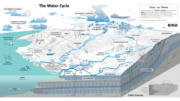BaCCC/Module 1/Lesson 1
Module 1, Lesson 1: Climate System Change
The climate system
A system is a set of parts or components that interact with one another. The climate system is no different. Its five major components are defined as:
- air (the atmosphere)
- water (the hydrosphere)
- ice (the cryosphere)
- rock (the lithosphere)
- life (the biosphere)
How they interact is what makes up the climate. The climate system is regarded as highly complex, given the massiveness of both its components and their interactions. From the definitions of the terms “weather” and “climate,” you may think that the atmosphere on its own is very important. But weather conditions depend on how the atmosphere interacts with other components of the climate system.
As mentioned earlier, the climate varies by region because of local differences in the components and interactions of the climate system. For example, mountains (the lithosphere or rock) can change the winds, or proximity to the ocean (the hydrosphere or water) can influence the temperature.
(You can adjust the playback speed and/or turn on subtitles/captions.)
If you have trouble accessing the video, a summary is available in Annex 1.1.1.
It is essential to take away from this video the importance of solar energy, as well as the knowledge that the climate is influenced by the land’s albedo (how much light the surface of the planet reflects), vegetation and soil moisture, as well as the movement and interactions of the atmosphere with large-scale ocean currents.
1. Study the diagrams in the links below and describe how components of the climate system interact with these cycles:
a) water cycle
b) carbon cycle (scroll down for the graphic)
2. Study the water cycle below and look up the short videos at Water Stories (scroll down here)
If all the forests or trees were cleared and all the water bodies dried up, how would this affect the water cycle? Would this then have a long- or short-term effect on climate?
Cite error: <ref> tags exist, but no <references/> tag was found


